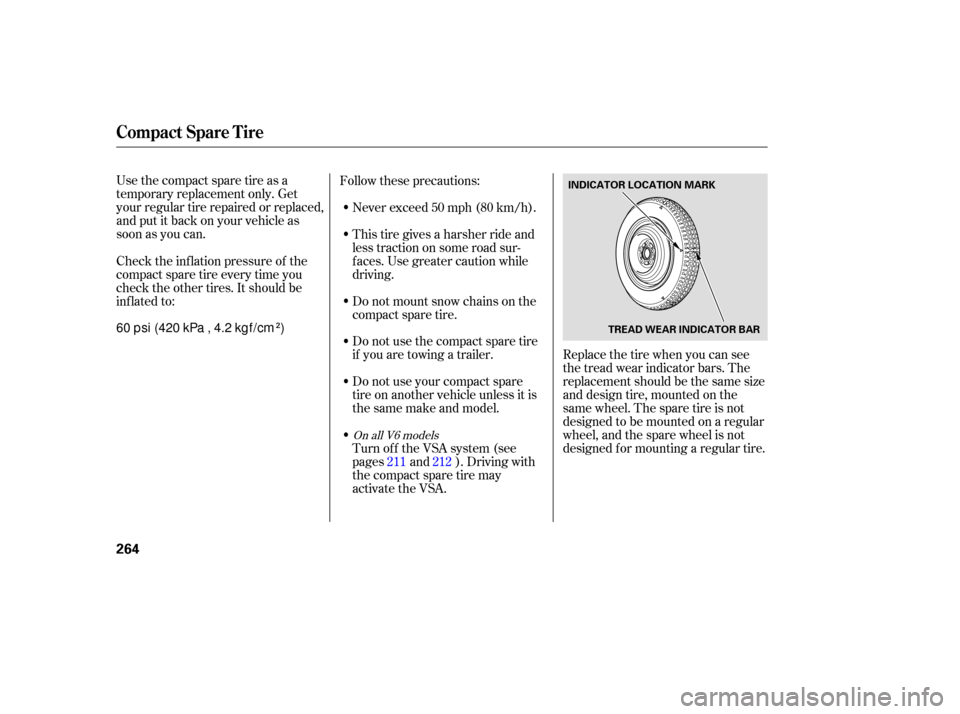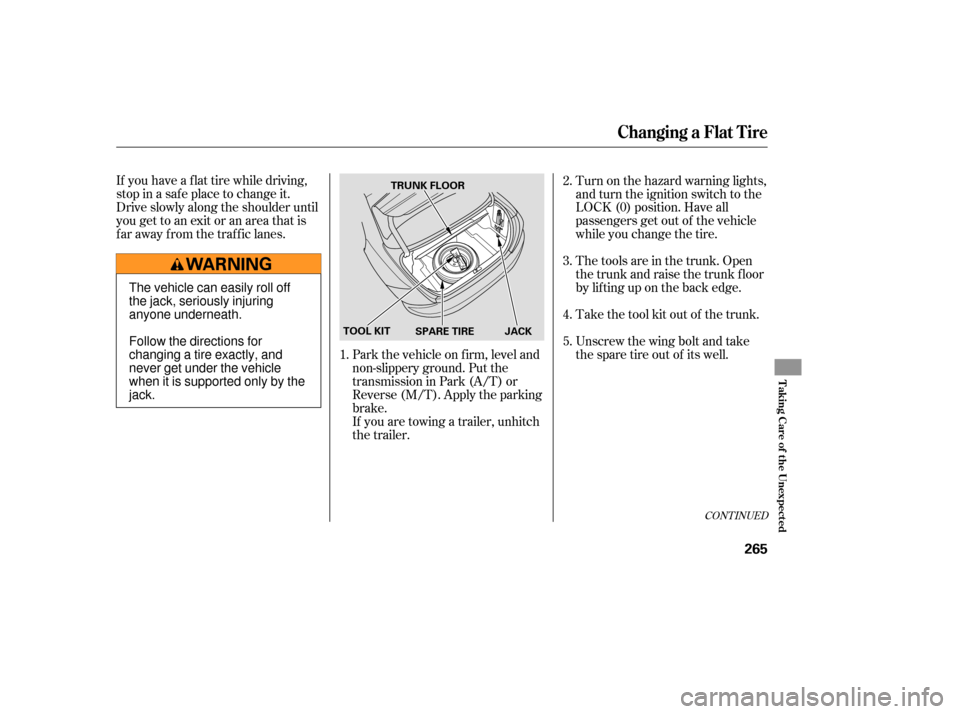Page 198 of 319
The cargo net can be used to help
hold down items stored in the trunk.
To use the cargo net, hook it to the
buttons on the f loor and sides of the
trunk. You can use the cargo net in
several conf igurations by hooking it
to dif f erent buttons.
When you are not using the cargo
net,storeitinthesparetirewell.
There are hooks on the f loor and
sides of the trunk. They can be used
to install a net f or securing items.
If you carry any items on a roof
rack,besurethetotalweightof
the rack and the items does not
exceed the maximum allowable
weight. Please contact your dealer
for further information.
If you use an accessory roof rack,
the roof rack weight limit may be
lower. Ref er to the inf ormation that
came with your roof rack.
On EX, EX-L, and EX-V6 models
Carrying Cargo
Cargo Net
T runk Hooks
196
�����—�����—�����y�
���������
���y���
�(���%�������y���
�����y
Page 214 of 319
Driving with varying tire or wheel
sizes may cause the VSA to
malfunction. When replacing tires,
make sure they are of the same size
and type as your original tires (see
page ).
This switch is under the left vent.
Press it to turn the VSA system on
and off.
When VSA is off, the VSA activation
indicator comes on as a reminder.
Pressing the switch again turns the
system back on. VSA
is turned on every time you
start the engine, even if you turn ed it
off the last time you drove the
vehicle.
Deactivate the VSA system if you
need to drive with the compact spare tire installed (see page ).
If you install winter tires, make sure
they are the same size as those that
were originally supplied with your
vehicle. Exercise the same caution
during winter driving as you would if
your vehicle was not equipped with
VSA. 264
258
Vehicle Stability Assist (VSA) System
VSA and Tire Sizes
VSA Of f Switch
212
VSA OFF SWITCH
�����—�����—�����y�
�������������y���
�(���%�������y�����
���y
Page 218 of 319

Many states and Canadian provinces
require special outside mirrors when
towing a trailer. Even if they don’t,
you should install special mirrors if
you cannot clearly see behind you, or
if the trailer creates a blind spot.
Askyourtrailersalesorrental
agency if any other items are
recommended or required f or your
towing situation.When preparing to tow, and bef ore
driving away, be sure to check the
f ollowing:
The vehicle has been properly
serviced, and the tires, brakes,
suspension, cooling system, and
lights are in good operating
condition.
All weights and loads are within
limits.
Thehitch,safetychains,andany
other attachments are secure.
All items in or on the trailer are
properly secured and cannot shif t
while you drive.
The lights and brakes on your
vehicle and the trailer are working
properly. Your vehicle tires and spare are
properly inf lated, and the trailer
tires and spare are inflated as
recommended by the trailer
maker.
A ddit ional T owing EquipmentPre-T ow Checklist
Towing a Trailer
216
�����—�����—�����y�
������
������y���
�(���%�������y�����
���y
Page 257 of 319

Keeping the tires properly inflated
provides the best combination of
handling, tread life, and riding
comfort.
Underinflated tires wear unevenly,
adversely affect handling and fuel
economy, and are more likely to
fail from being overheated.
Overinflated tires can make your
vehicleridemoreharshly,are
more prone to damage from road
hazards, and wear unevenly.
We recommend that you visually
check your tires every day. If you
think a tire might be low, check it
immediately with a tire gauge. Use
a gauge to measure the air
pressure in each tire at least once a
month. Even tires that are in good
condition may lose 1 to 2 psi (10 to
20 kPa, 0.1 to 0.2 kgf/cm ) per
month. Remember to check the
sparetireatthesametime.
Check the air pressures when the
tires are cold. This means the
vehicle has been parked for at least 3
hours, or driven less than 1 mile (1.6
km). Add or release air, if needed, to
match the recommended cold tire
pressures on page . If you check air pressure when the
tires are hot [driven f or several miles
(kilometers)], you will see readings 4
to6psi(30to40kPa,0.3to0.4
kgf /cm ) higher than the cold
readings. This is normal. Do not let
air out to match the recommended
cold air pressure. The tire will be
underinf lated.
Youshoulduseyourowntire
pressure gauge whenever you check
your tire pressures. This will make it
easier f or you to tell if a pressure
loss is due to a tire problem and not
due to a variation between gauges.
While tubeless tires have some
ability to self -seal if they are
punctured, you should look closely
for punctures if a tire starts losing
pressure.
256
Tires
Inf lation Guidelines
Maint enance
255
�����—�����—�����y�
�������������y���
�(���%�������y���������y
Page 258 of 319

The following chart shows the
recommended cold tire pressures for
most normal and high-speed driving
conditions.
Excessive tread wear.
Cu
ts, splits, or cracks in the side
of the tire. Replace the tire if you
can see fabric or cord.
Bumps
or bulges in the tread or
side of the tire. Replace the tire if
youfindeitheroftheseconditions.
Every
time you check inflation, you
should also examine the tires for
damage, foreign objects, and wear.
Youshouldlookfor: For convenience, the recommended
tire sizes and cold tire pressures are
on a lab el on the driver’s doorjamb.
For additional inf ormation about
your tires, see page . 296Tire Size/Type
Compact Spare Cold Tire Pressure
Tire Size/Type Compact Spare Cold Tire Pressure
Tire Size/Type
Compact Spare Cold Tire Pressure
Front:
Rear: Front:
Rear:
Front:
Rear:
6-cylinder models
Canadian 4-cylinder LX models
All 4-cylinder models except Canadian LX
Tires
Recommended Tire Pressures
Tire Inspection
256
P205/65R15 92H30 psi (210 kPa ,
2.1 kgf/cm)
29 psi (200 kPa , 2.0 kgf/cm
)
60 psi (420 kPa , 4.2 kgf/cm
)
32 psi (220 kPa , 2.2 kgf/cm
)
29 psi (200 kPa , 2.0 kgf/cm
)
60 psi (420 kPa , 4.2 kgf/cm
)
32 psi (220 kPa ,
2.2 kgf/cm
)
30 psi (210 kPa , 2.1 kgf/cm
)
60 psi (420 kPa , 4.2 kgf/cm
)
P205/60R16 91V
P215/50R17 93V
�����—�����—�����y�
�������������y���
�(���%�������y���������y
Page 265 of 319

This section covers the more
common problems that motorists
experience with their vehicles. It
gives you inf ormation about how to
safely evaluate the problem and what
to do to correct it. If the problem has
stranded you on the side of the road,
you may be able to get going again.
If not, you will also f ind instructions
on getting your vehicle towed.......................
Compact Spare Tire .264
....................
Changing a Flat Tire .265
.............
If the Engine Won’t Start .270
................................
Jump Starting .272
..............
If the Engine Overheats .274
.........
Low Oil Pressure Indicator .276
..........
Charging System Indicator .276
.......
Malf unction Indicator Lamp .277
...............
Brake System Indicator .278
..................
Closing the Moonroof .279
..............................................
Fuses .280
..............................
Fuse Locations .283
......................
Emergency Towing .285
Taking Care of the Unexpected
T aking Care of t he Unexpect ed
263
�����—�����—�����y�
�������������y���
�(���%�������y���������y
Page 266 of 319

Use the compact spare tire as a
temporary replacement only. Get
your regular tire repaired or replaced,
and put it back on your vehicle as
soon as you can. Follow
these precautions:
Do not use your compact spare
tire on another vehicle unless it is
thesamemakeandmodel. Do not use the compact spare tire
if you are towing a trailer. Replace the tire when you can see
the tread wear indica tor bars. The
replacement should be the same size
and design tire, mounted on the
same wheel. The spare tire is not
designed to be mounted on a regular
wheel, and the spare wheel is not
designed for mounting a regular tire.
Check
the inflation pressure of the
compact spare tire every time you
check the other tires. It should be
inflated to: Never
exceed 50 mph (80 km/h).
This tire gives a harsher ride and
less traction on some road sur-
f aces. Use greater caution while
driving.
Do not mount snow chains on the
compact spare tire.
Turn of f the VSA system (see
pages and ). Driving with
thecompactsparetiremay
activate the VSA. 211 212
On all V6 models
Compact Spare Tire
264
INDICATOR LOCATION MARK
TREAD WEAR INDICATOR BAR
60 psi (420 kPa , 4.2 kgf/cm)
�����—�����—�����y�
���������
���y���
�(���%�������y���������y
Page 267 of 319

CONT INUED
If you have a f lat tire while driving,
stop in a saf e place to change it.
Drive slowly along the shoulder until
you get to an exit or an area that is
far away from the traffic lanes.If you are towing a trailer, unhitch
the trailer. Park the vehicle on f irm, level and
non-slippery ground. Put the
transmission in Park (A/T) or
Reverse (M/T). Apply the parking
brake.Turn on the hazard warning lights,
and turn the ignition switch to the
LOCK (0) position. Have all
passengers get out of the vehicle
while you change the tire.
The tools are in the trunk. Open
the trunk and raise the trunk f loor
by lif ting up on the back edge.
Take the tool kit out of the trunk.
Unscrew the wing bolt and take
the spare tire out of its well.
5. 4. 3. 2.
1.
Changing a Flat Tire
T aking Care of t he Unexpect ed
265
TRUNK FLOOR
SPARE TIRE JACK
TOOL KIT
The vehicle can easily roll off
the jack, seriously injuring
anyone underneath.
Follow the directions for
changing a tire exactly, and
never get under the vehicle
when it is supported only by the
jack.
�����—�����—�����y�
�����������
�y���
�(���%�������y���������y